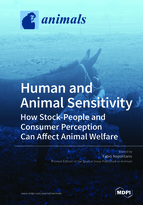Human and Animal Sensitivity: How Stock-People and Consumer Perception Can Affect Animal Welfare
A special issue of Animals (ISSN 2076-2615). This special issue belongs to the section "Animal Welfare".
Deadline for manuscript submissions: closed (31 March 2019) | Viewed by 76809
Special Issue Editor
Special Issue Information
Dear Colleagues,
We are proposing a Special Issue based on an oxymoron: although animal welfare is all about how the animals perceive the surrounding environment, the actual welfare of the animals is dependent on how the stakeholders perceive and weigh animal welfare, as they can either directly (i.e., through stock-people interacting with the animals), or indirectly (e.g., because retailers and consumers are willing to pay more for high welfare animal-based products) affect the way animals are kept and handled in the farm, while they are being transported and are at slaughter.
“How to improve stock-people attitude and behaviour towards the animals? How to increase consumer sensitivity to animal welfare issues?” These are only some of the questions that will be addressed in this Special Issue.
The entire food chain is at stake. We are, therefore, looking for cross-discipline studies that cover aspects ranging from animal science to social/consumer sciences and psychology with a unified goal: collecting and disseminating information suitable to promote the continuous enhancement of animal welfare by improving stakeholders’ perception of animal welfare.
Prof. Fabio Napolitano
Guest Editor
Manuscript Submission Information
Manuscripts should be submitted online at www.mdpi.com by registering and logging in to this website. Once you are registered, click here to go to the submission form. Manuscripts can be submitted until the deadline. All submissions that pass pre-check are peer-reviewed. Accepted papers will be published continuously in the journal (as soon as accepted) and will be listed together on the special issue website. Research articles, review articles as well as short communications are invited. For planned papers, a title and short abstract (about 100 words) can be sent to the Editorial Office for announcement on this website.
Submitted manuscripts should not have been published previously, nor be under consideration for publication elsewhere (except conference proceedings papers). All manuscripts are thoroughly refereed through a single-blind peer-review process. A guide for authors and other relevant information for submission of manuscripts is available on the Instructions for Authors page. Animals is an international peer-reviewed open access semimonthly journal published by MDPI.
Please visit the Instructions for Authors page before submitting a manuscript. The Article Processing Charge (APC) for publication in this open access journal is 2400 CHF (Swiss Francs). Submitted papers should be well formatted and use good English. Authors may use MDPI's English editing service prior to publication or during author revisions.
Keywords
- animal welfare
- animal behaviour
- emotional state
- human-animal interaction
- stock-people attitude
- stock-people behaviour
- retailers
- consumer perception
- consumer willingness to pay
- marketing







